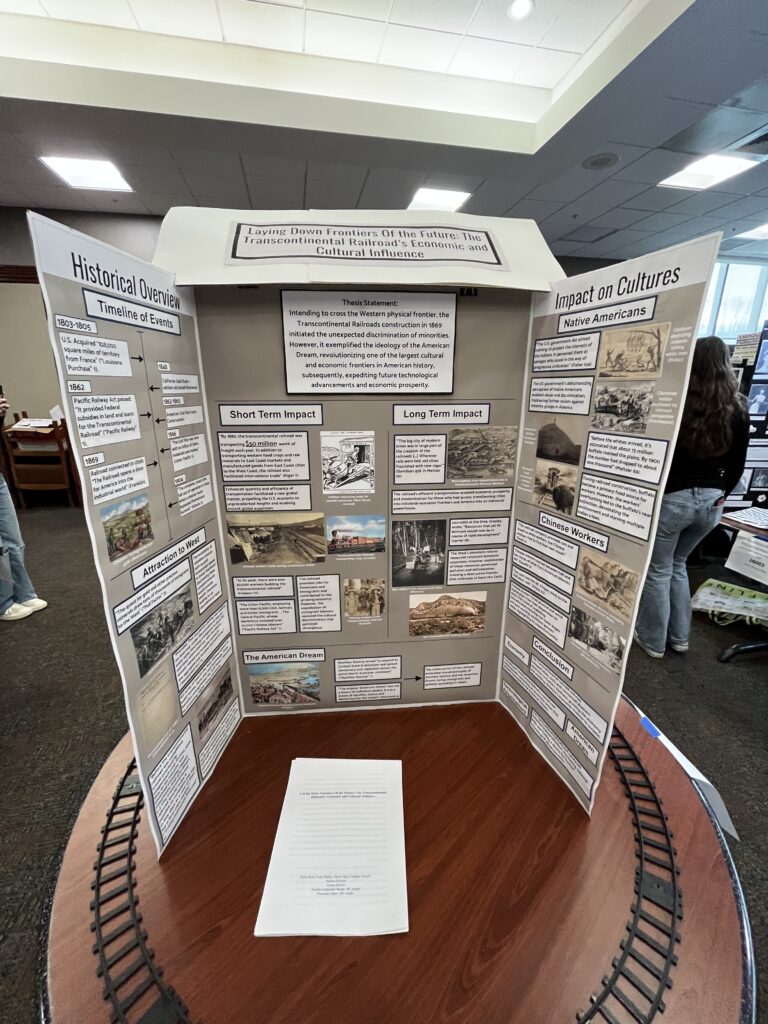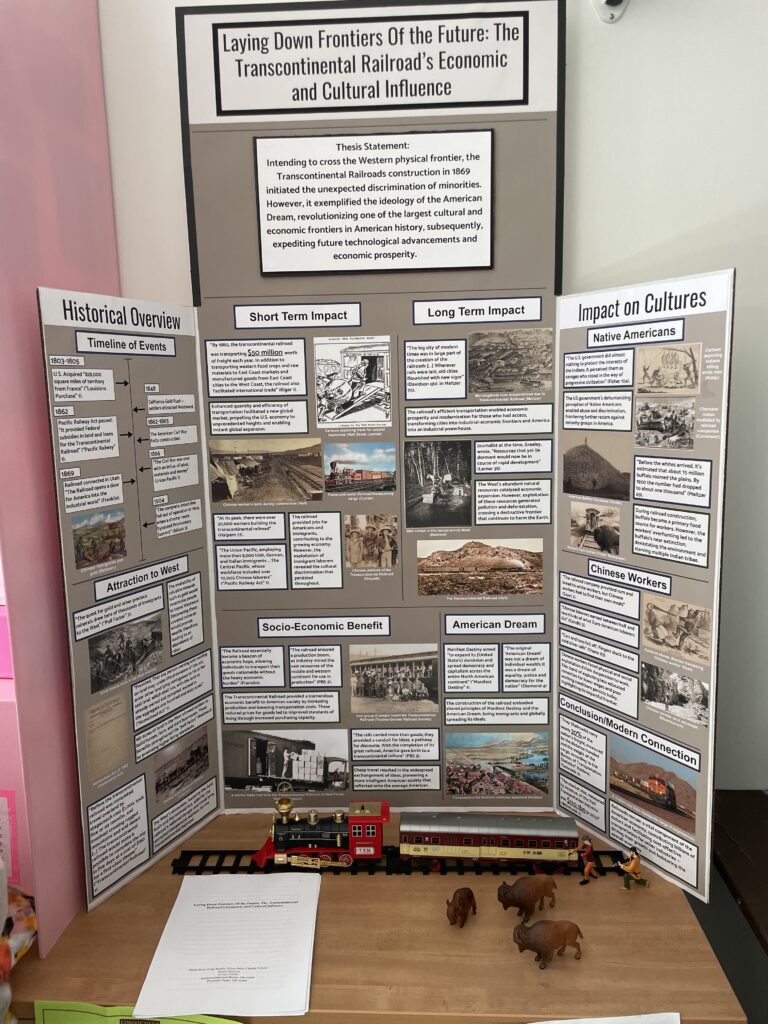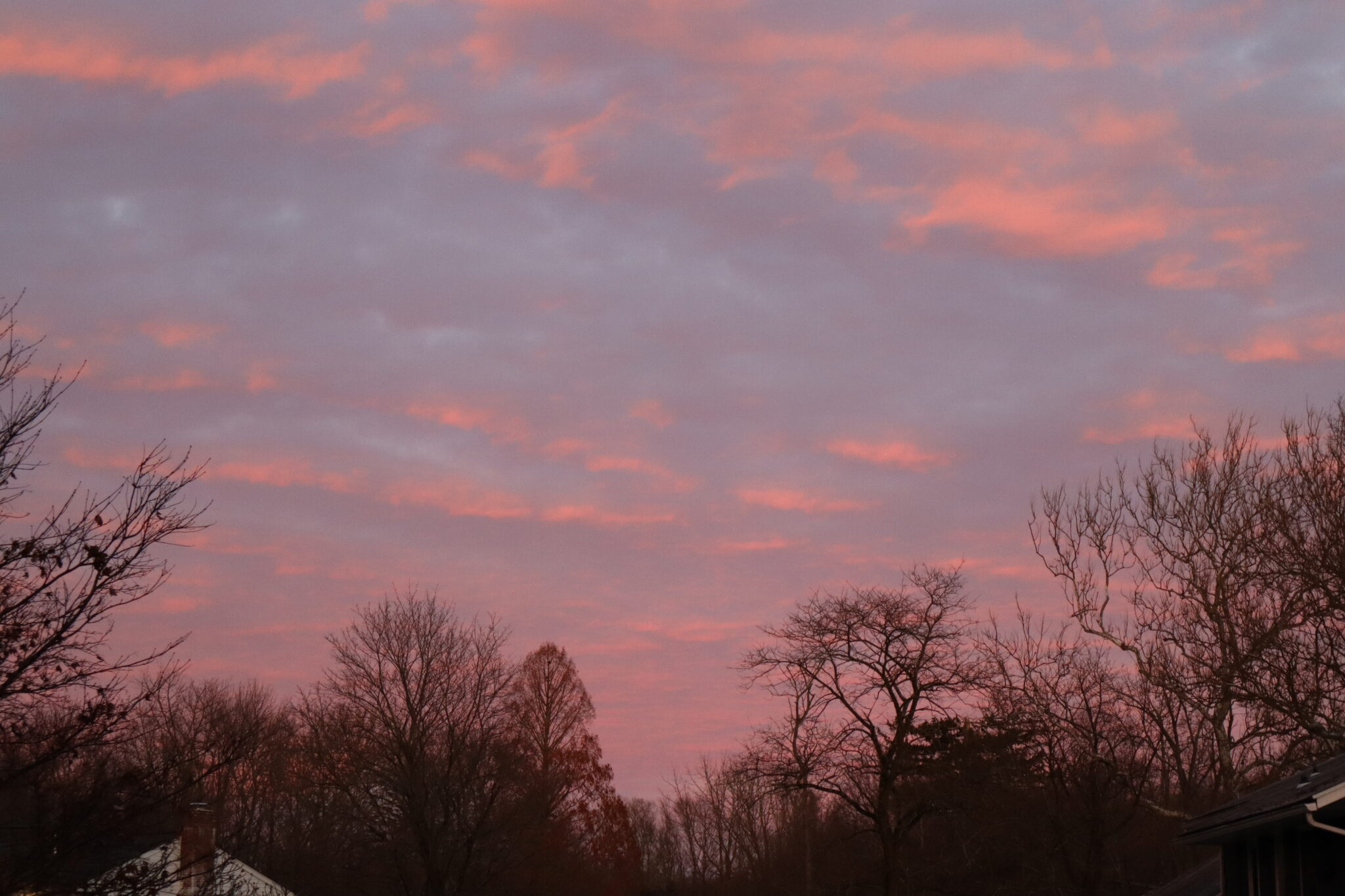Competition
Around this time last year, I participated in my first history competition (the regional NHD competition). The competition itself was a required part of a course I took that year. Originally, my group and I did not put much thought into competing, but after receiving an oddly high grade on the midterm prototype, we figured to enter the competition.
The day of the competition, one of my group members got sick, and the other one didn’t know the material well enough, so I ended up just going with my friend (who was also in the group). When we arrived, we set up our project on the table provided, installed the plastic train around the poster, turned on the train, and then left. Besides periodic checks about once an hour and the 15-minute interview, we never went back. It was probably a combination of not wanting to stand awkwardly gatekeeping our project and being intimidated by the other, far more visually appealing projects that drove us away.
Here is a photo of the project on competition day (it’s a bad angle and the title had fallen down):

As you can tell, it didn’t have the same pop factor as other groups, and it certainly wasn’t as tall, but in the long run it was the content that mattered. I think I was one of the few (if any) kids to read the entire rule book for the competition and realize that the judges’ scores were based on 80% content and 20% visual. While many other groups focused on creating a visually intricate design for their posters, we focused on our content and created a well-organized and logical argument.
After 6-ish hours, it was time for the awards ceremony. I remember sitting down with some nerves, hoping to win something. I didn’t think anything was going to happen, especially after the judges called the third-place poster, which was about 8 feet in height and visually looked great. My friend and I both shared a look of surprise that there were two posters better than that one, and realization that we had most certainly lost. Then the judges called the second-place group, again not us, but a far more moderate project. Maybe a bit of hope was restored, but not much. But then the woman called out: “Laying down frontiers of the future: the transcontinental railroads economic and cultural influence.” We expressed a face of confusion and joy as we stood up and began making our way to the stage.
Placing among the top three also meant we qualified for the state history day competition in a month or so. After far exceeding our expectations, we also participated in the state competition. We revised the project quite a bit and ended up making the middle taller because we had more information to include. In the end, this was the final project at the state competition:

If we didn’t think we would place in the regional competition, we definitely didn’t think we would place in the state one. This time, we needed at least second place to qualify for the national competition. The whole experience was almost a mirrored image to the first, except this time the judge somehow called our project for second place. It allowed us to qualify for the national competition and gave us a 100 for the final project of the class.
As a group, we didn’t end up making any more changes to the final project, as the national competition itself coincided with finals week and I couldn’t go, but we still did decent at nationals, somewhere around 20th place.
The experience was a lot of work, but doing well was worth it. If I did it again (which I am not), these are a few tips I would give:
- Spend around a week picking a topic — it may seem unusually long but having a good and easily connectable topic makes the rest of the project far easier. In fact, one of the rubric points is solely for the topic selection.
- Save your words for analysis — the poster only has 500 student composed words, and this includes the thesis. Don’t write intricate and descriptive captions and use quotes and images for evidence.
- Prioritize content — as long as the poster is not ugly, the content is what matters. Don’t get caught up in engineering some project that will take up your time, and instead do something a bit simpler. For reference, I got full marks from each judge in the visual category at each competition level.
The Constitution
Yesterday, my Gov class also competed at the We The People state competition. I find it funny how different branches of American history can be. With NHD, my time was spent finding quotes and working on annotated bibliographies. With We The People, it is spent memorizing delegates and the Constitution. After prepping since September, we finally took the trip to Yale and competed at the state competition. To my surprise, there were only 4 schools there, a number I thought would have been closer to 20. Connecticut is also given a wild card to send to nationals, allowing the two winning schools to both go to the national competition. This was needed, as after another long 5 hours of sitting in a lecture hall, we ended up tying for first place with another school. I found this funny, as we both had 1483 total points, but I guess that’s a good thing, because we can both say we won the competition.
We now have the national competition in April, except this time I will be going with the class during our April break — a trip I look forward to.





